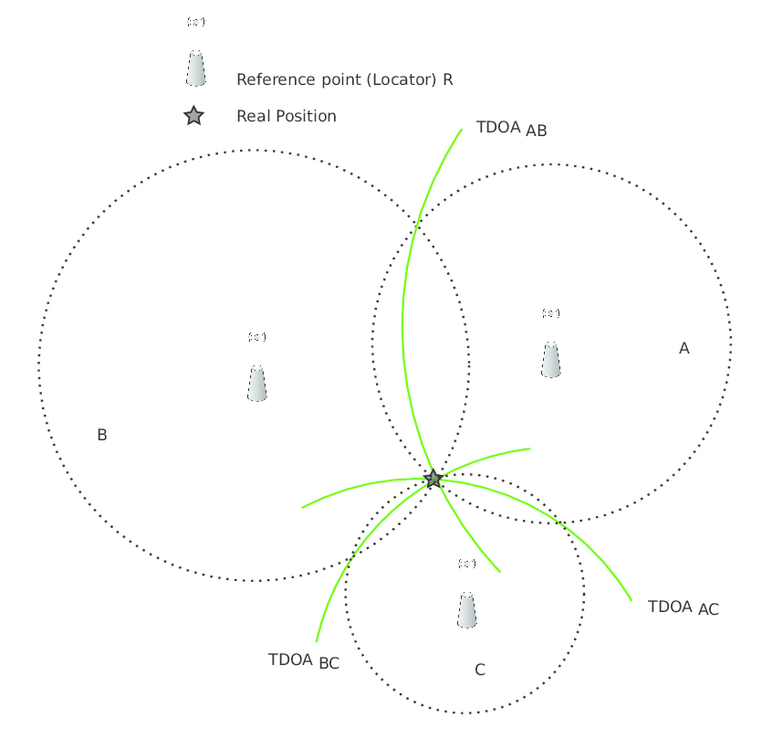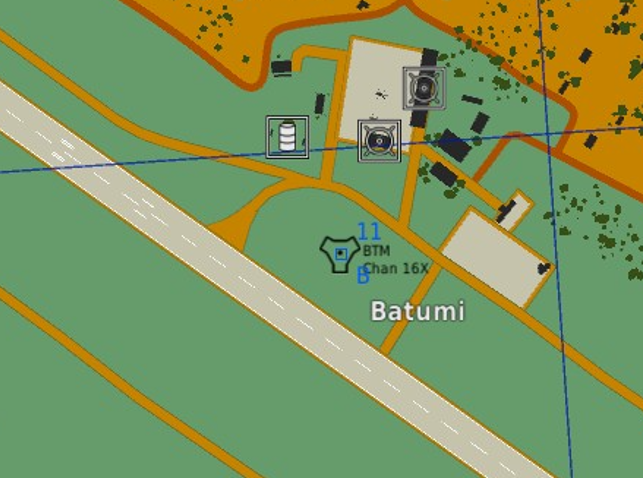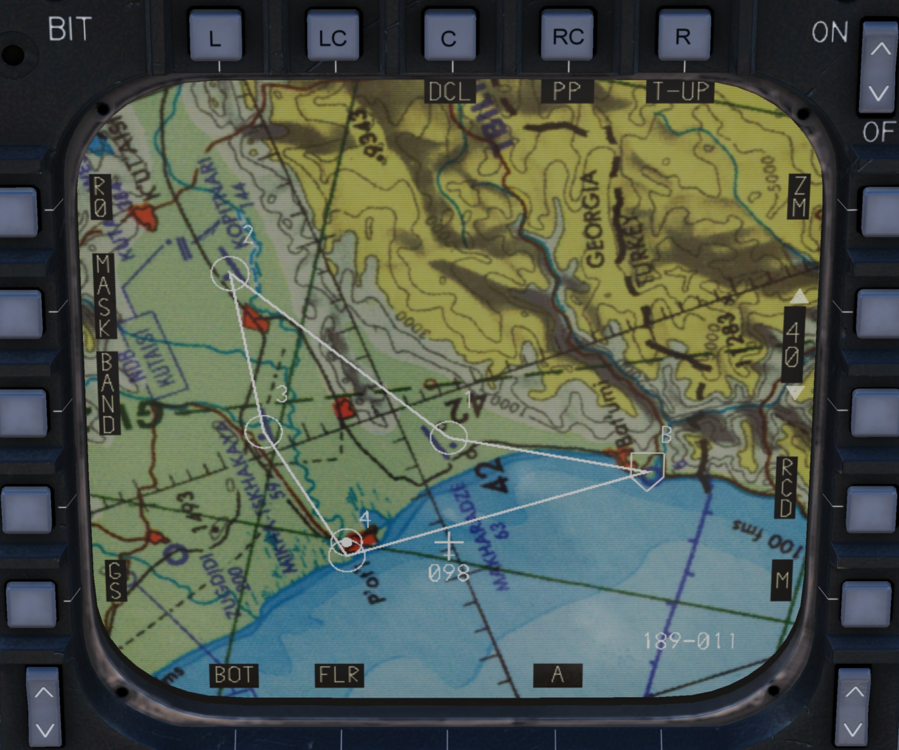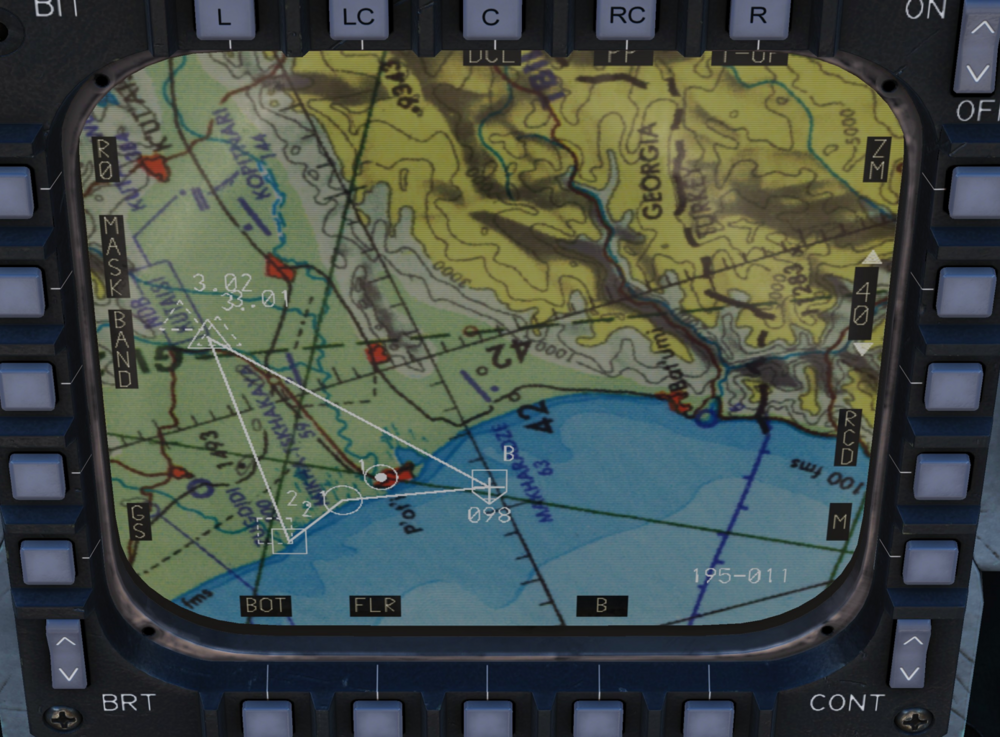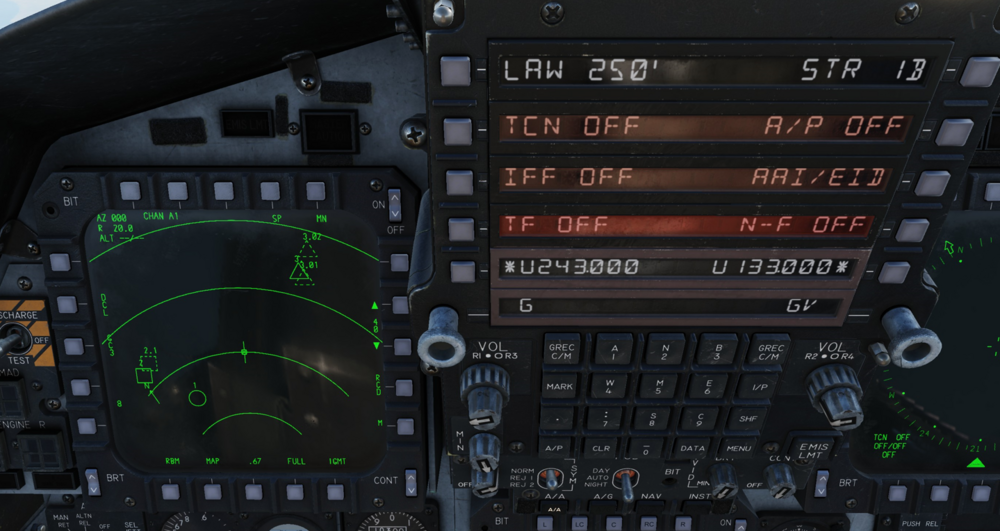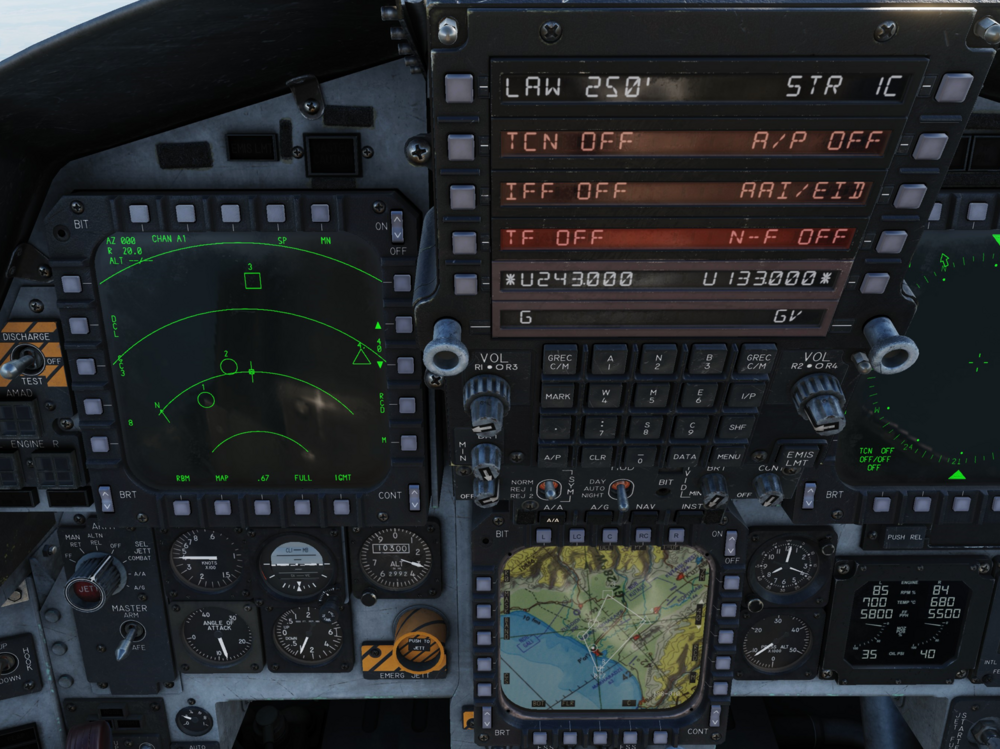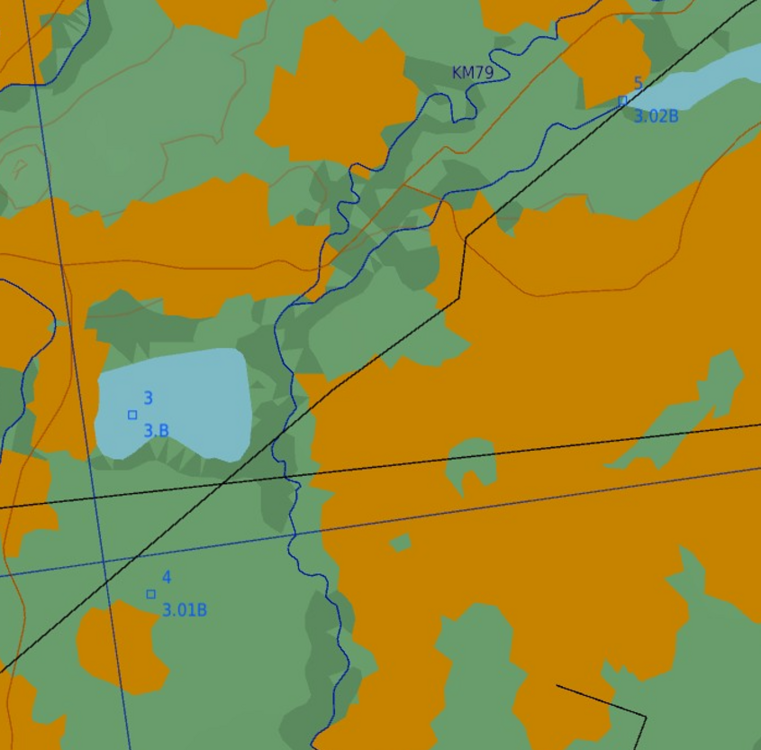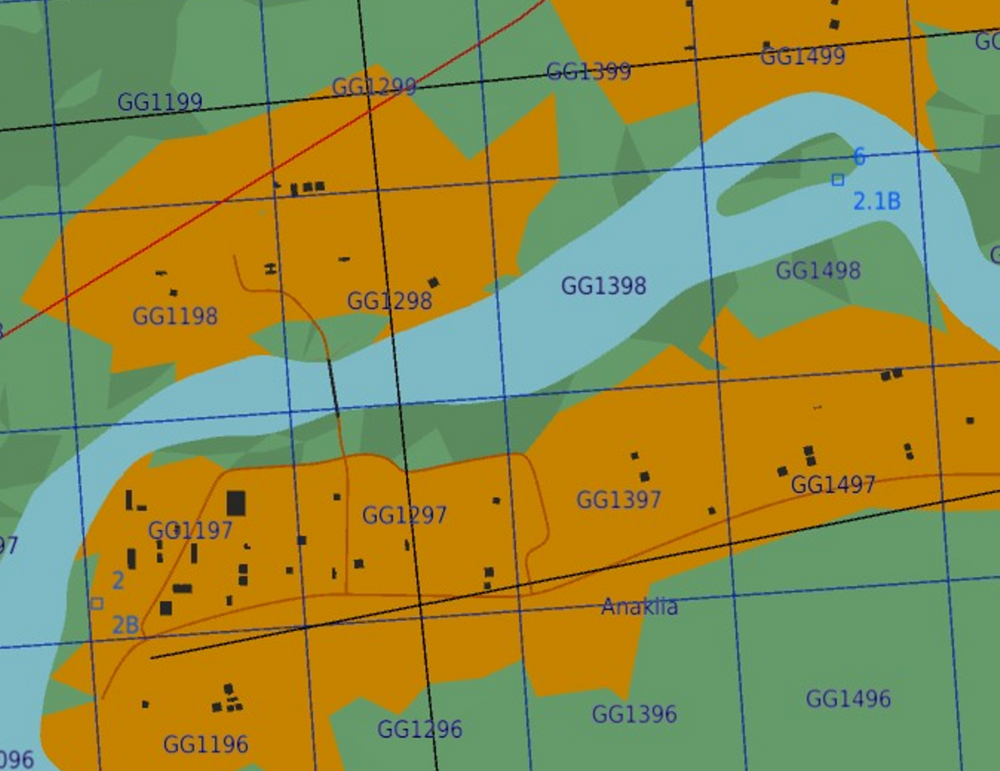

KlarSnow
Members-
Posts
561 -
Joined
-
Last visited
-
Days Won
4
Content Type
Profiles
Forums
Events
Everything posted by KlarSnow
-
Its half action plus TDC press. Pulling half action on its own does nothing on an HRM map. You can test it in game and see. This is how it works in game currently and is correct behavior.
-
It should only transfer from the pod if you make a designation. Just cuing the pod does not enable pod transfer, or shouldn’t. If it is that is a bug and should get fixed. Currently no there is no good way to quickly transfer markpoints into bombs, whenever the SIT gets implemented that will enable transferring markpoints from the SIT directly into JDAMs
-
The bomb release order is set in the jets PACS and unchangeable. It always releases in the order aft inboard, forward inboard, aft outboard, forward outboard, middle outboard, middle inboard. This maintains the best CG balance and avoids an aft CG condition which is far less desirable than a forward CG condition. If a station is not loaded then it is skipped in the sequence. If you have both CFTs selected and a Ripple Single program then it always starts with the Left CFT first. The situation presented at the top is a bug, Ripple multiple should take the quantity of weapons to be released and divide it by number of stations selected, and thats how many release pulses are sent, rounded up. So in the example given above 5 bombs should have released at once; one from each of the selected stations. If the quantity had been 10, it would have only ended up releasing 7 bombs (because there is only one bomb on three of the selected stations) If however you had the CFTs only selected and had set a qty of 3, then 4 bombs would be released, since its 3 bombs divided by 2 stations would be 2 pulses sent to the two selected stations, so 4 bombs would be released.
-
You should go look up the principles behind TDOA, TDOA is Time difference of Arrival, not angular measurements. Each station is receiving and synchronizing the time of arrival of a particular signal and using that time sync to generate a location. With 1 station all you get is a range, thus a circle around your aircraft. 2 stations would give you a pair of potential locations, and 3 stations gives you a very accurate location. This does not work the same way as angle based triangulation systems. Each intersection of a circle is the potential location of the target, only where all three intersect is the true location.
- 14 replies
-
- 11
-

-

-
Of note that -34 refers to the backseater as the “pilot” and the front seater as the “AC” or “Aircraft Commander”
-
The gun sight. What you see in this screenshot of the module that Heatblur posted on FB is all the HUD you will get in the F-4.
-

F-15E Radar Modes HOTAS Diagram & Azimuth vs Elevation Plots
KlarSnow replied to CourageousPotato's topic in F-15E
It means put the cursors over the text in the Bit window in the lower left corner of the radar and TDC press short Like this... Which then results in this... l For DTT this video when it uploads shows the process, go into a TWS mode, have a PDT, and an SDT, cursor on the SDT, and hold the TDC down long, you will after a second see the cursor jump towards the center of the scope and the bit window will show DTT, and you can see the sweep change from a TWS sweep, to a miniraster that bounces between the two targets. -
No the elevation is always on the ground at the steerpoints location. You should be able to manually edit the altitude once in the cockpit if you want the steerpoint floating in the air
-
Additionally if you want to do the A route with navpoints, that also works, it will overwrite the main route you have entered. You can also do multiple Bullseyes with B1-B10, there is no way to change which bullseye the aircraft is using right now though, so B1 is all that you can have on the displays. You can look at the bullseyes in the steerpoint submenu and see that they have been entered. Listpoints also work, L1-L99 IIRC is the limit there. and you can then use them to build routes quickly by matching listpoints to steerpoints. There is no editing Listpoints in the jet though.
-
You can also set the Base point (home plate symbol) somewhere other than your aircraft spawn location for airstarts. You do this by just having a nav point labelled B. Like so And in the jet upon an airstart
-
Offset and target points do work on alternate routes you label them exactly as you see in the UFC. You can also see the B and C route on the A/G radar, but you have to be steering to it on the UFC, you cant cycle through them without steering to them like you can on the TSD. Avoidance points are not implemented yet. That will probably be waiting for a TSD overhaul and a lot of the functionality that should go with that. Offset and target points and aimpoints on the B route null B route on the A/G radar C route on the A/G radar and the TSD And the Aimpoint for the B route Target and Offsets for the B route
-
Listen to the beeps. When you hear the single rate beeper you are at 80-90% of the current G limit, when you hear it beep twice as fast you are at 90-99% of the current G limit. If you hear a solid tone you are right at the G limit (100%) and if you hear "OVER-G OVER-G" then you are over the g limit. basically if you hear the beeps get faster, dont pull anymore. Thats your cue that you are about to break something.
-
So just something to remember about the navflir pod. Its viewport is not coincident with the HUD POV. So while the FOV matches, the pod itself is located 10 feet below and 5 feet right of the cockpit (and 10-15 feet aft of the HUD) Basically what this means is there will always be some parallax. So far in DCS I have not had to do any yaw adjustment, however if it gets misaligned vertically a pitch boresight of 61 should line that up. Additionally when boresighting it, do not use things close by to align the image with the outside world (hangars, taxiway symbols etc...) use distant objects like the horizon, clouds, far off objects etc. If you align it to objects close by (and especially if you add significant yaw values) then you are going to have an extremely messed up image up at altitude
-
The bar setting itself will not change. Look at the actual elevation coverage and see if that changes. The bar setting on the left side of the scope will not change when you enter search sort.
-

CDIP uses tgt point designation elev data. BUG
KlarSnow replied to Brainfreeze's topic in Bugs and Problems
This is accurate and not a bug. If there is no active sensor providing the height above target then the CDIP calculation pulls the current designation or closest steerpoint elevation and uses that. Suite 4 as implemented does not have DTED tied into its bombing calculations. Your only sources right now for height above target are SYS, wwhich isaircraft barometric or GPS corrected altitude compared to the steerpoint elevation. Or LAS which is the target pod latched to the CDIP reticle with the laser firing. The other parts of the height above target hierarchy: Air to ground radar ranging, Radar altimeter, HRM and Passive are not implemented. of those, only Radar altimeter an Air to ground radar ranging would help with CDIP bombing.- 1 reply
-
- 5
-

-

-

F-15E Radar Modes HOTAS Diagram & Azimuth vs Elevation Plots
KlarSnow replied to CourageousPotato's topic in F-15E
range scale on the radar determines bar spacing in RWS. 3.4 deg on a 10 NM scope 2.5 deg on a 20 NM scope 1 degree on a 40, 80 or 60 NM scope -
The right wing tip is the fuel dump, the left wingtip is the overflow vent. Dump switch only puts fuel out the right wingtip. The left wingtip only vents fuel when an overpressure or overfueled condition exists. Not controllable by the aircrew, completely automatic. Unlikely to see it happen in DCS.
-
WSO pickle button is only connected to air to ground release circuits. No Trigger in the backseat. You can use the HUD repeater to employ CDIP or AUTO with any bomb. The WSO cannot fire AAM's or the gun.
-
All navigation steering should be wind corrected to a steerpoint. That is just the default. You can tell it is not because your flightpath marker in the first screenshot is off to the side of the steerpoint circle. It should be directly over it. So the heading correction is wrong. There are many things incorrect or not matched up correctly between the HUD and HSI steering cues currently. Its quite frustrating because the relationships between all this symbology and what is steering to what remains the same even in bombing modes. And its how you perform blind wind corrected AUTO bombing if you cant see the ASL for whatever reason. Currently that is essentially impossible and you have to ignore or misalign steering cues to get things to hit in any wind.
-

How to designate OFFSET target? Bug I suppose?
KlarSnow replied to YoYo's topic in Bugs and Problems
Designating an offset designates the target point associated with it. The idea for offsets is not they are more targets, but a relative location to give you steering to the actual target. When you designate with an offset in PB17 it designated the associated target point at the relative bearing and range to the offset. so for example target point 4.A with offsets 4.01A and 4.02A 4.01A is 5000 feet due north of 4.A 4.02A is 3 miles due west of 4.A if you have 4.01A in PB 17 and squeeze a designation with target cursor function, 4.A will snap 5000 feet south of your cursor location and will be designated and you will get steering to it. If you have 4.02A in PB 17 and squeeze a designation with target cursor function, 4.A will snap to 3 miles east of your cursor location, and will be designated and you will get steering to it. This is how offsets work. you use them to locate and cue you to the target point, not as targets on their own. -

How to designate OFFSET target? Bug I suppose?
KlarSnow replied to YoYo's topic in Bugs and Problems
designating an offset designates the target. Offsets are not additional targets they are offsets. When you have TGT cursor function and designate with an offset in PB17, it will designate the target point associated with the offset at the bearing and range from the offset that was saved. The behavior you are seeing is correct. -

Can you centre the pitch ladder in windy conditions?
KlarSnow replied to DD_fruitbat's topic in F-15E
Yes, but it is not implemented yet. In Nav/Inst master modes Multifunction switch on the throttle press is supposed to cage the velocity vector and pitch ladder to the center of the HUD and give you a ghost flight path marker. Not implemented currently. -

The 25000 feet limit on the LANTIRN tgp
KlarSnow replied to michael_rub's topic in Controller Questions and Bugs
no it never got any updates to the LANTIRN. LANTIRN was briefly supplemented by LITENING (a few LITENING pods sprinkled around the deployed squadrons with mostly LANTIRN) when OIR/OIF kicked off, and then both were replaced completely (eventually) by SNIPER. -
INS PVU once a flight. Especially if you are INS only. If you have EGI its not really necessary right now from what I can tell. IF you are INS only it is also probably advisable for best maps to do an MN PVU prior to every map. or at least one every few minutes that you are intending to do maps. the real thing dumps the correction values from the MN PVU after 5 minutes because it assumes at that point they are no longer valid, so you plan your MN PVU's and mapping legs so that you are doing a MN PVU within 5 minutes of every desired mapping point. if you are EGI only unless you are having issues with your maps being unreadable you really shouldnt "need" to do either of these.
-
I dont think MN is implemented currently as a PPKS in the current DCS F-15E. Hopefully we get it implemented at some point because without EGI MN should be your primary PPKS, not INS. INS as a primary PPKS is a rare thing in the F-15E. MN on the top right of the A/G Radar display should only show up if you are in update cursor mode. Then you can toggle that to update either the MN or the INS with the position update. Normally you would have it in MN and just update the MN if you were flying INS only. When you select PVU it defaults to an MN PVU which can actually have benefits in DCS right now even though the MN is not a functioning separate PPKS at the moment. It can result in clearer/cleaner/easier to read maps, but you want to do the MN PVU shortly before making your map. The effect it has on cleaning up the picture only lasts a few minutes. INS PVU no you don't need to wait for 3-6 minutes, as soon as you see values in the 0.1-0.2 region you can accept it and you will be good to go. In the real thing continuing a longer INS PVU for several minutes does have long term benefits so it was something performed every now and then. A quick INS PVU should be done every flight to help keep the radar and INS calibrated, a long one is performed after significant system changes (big radar maintenance, replacing the Central Computer or other significant computers or processing centers in the jet. replacing the INS etc...) because that will help calibrate the system over the course of its life by giving it a much more accurate correction for the pointing errors. Assuming that has already been done, a short one just to get the system calibrated and your values down to 0.2-0.1 or so is plenty good.

